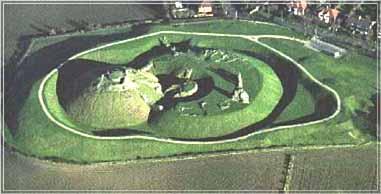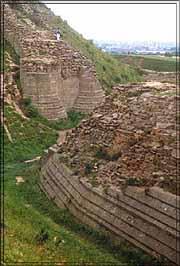Yorksview
SANDAL CASTLE

Richard of York Gave Battle in Vain
This well-known saying, taught to kids for many years, is the way we remember the order of the colour spectrum of the rainbow. Many will remember that the initial letters give you the colours in order. I think this is so.
When I think of this saying however, I always think of The Battle of Wakefield, fought near Sandal Castle on December 30th 1460.
This is because Richard really did give battle in vain!
I visited Sandal Castle, Wakefield’s greatest treasure, this week. Over the years, since I was a kid in the 1950’s, the authorities have excavated the site thoroughly, and landscaped it for the visitor. You can see the castle clearly from the M1 some distance away, as you hurtle along, but stop off! You can see one of the most interesting castles in Britain. It is a ruin! Be warned! You need to have brought your imagination with you as well, which, like the site - is free, a boon to any Yorkshire type).
They've installed some stairways. These give improved views, which allow a better appreciation of the ruined castle, and its surroundings, and there is a small visitor centre with interesting background information and visitor friendly exhibits.
On the site of the ruined keep, high up, (the keep will have originally been much higher of course, allowing an even more favourable view), there is a splendid viewing platform which enables you to understand how clever the original post Conquest castle builders were in selecting this perfect site, though the local vandals have removed some of the grassed area and thrown it into the tower’s entrails. (Perhaps they should be allowed to revisit mediaeval times to see how their actions would have been judged- now there’s an image!)
The famous battle which was fought was a short but important, skirmish- not, as bloody as, or as significant as Towton (March 1461 - the bloodiest battle on English soil), but significant for the death of Richard Plantagenet, a key claimant (or usurper - whichever is your point of view) to the throne of Henry VI in the Wars of the Roses. Richard Plantagenet, Duke of York, father of Edward IV and Richard III, is remembered for losing the battle in a foolhardy manner, being dead apparently only half an hour after leading out his troops on a most foolish errand.
Thereby hangs an intriguing mystery…..
Given it was Christmas in a medieval winter, given he was far away from his main armies in Derbyshire, given he was safe in one of the strongest castles in England, given he was advised by all good counsel to remain, why did he leave its walls and throw away his life in what was to all intent and purpose a Lancastrian trap!
I take no side in the lingering controversy over the Wars of the Roses themselves, but I do know that people should not take a black and white, or red and white, view as to who are the goodies and baddies in this period of history. Dynastic struggles and judgement upon them, I’ll leave to real historians, (though I did think that Simon Schama ducked the matter in his otherwise excellent TV series on British History).
| Events are shrouded in mystery and only evidenced by hearsay and unclear sources, but it does appear that the Lancastrians, camped one mile away on the flat, wooded plain between the castle and the City of Wakefield (now occupied by a housing estate), had at their disposal three times as many troops (15,000 to 5,000), better intelligence of the area than Richard’s forces, and that special northern gift – guile! (Disinformation - we might say today). (Some chroniclers say the Lancastrians had spies within the Castle - disguised as Richard’s men). This, coupled with total complacency on Richard’s part, seems to have led to his downfall. |
|
He decided rashly to take on a superior force, on a ground of his enemies’ choosing, hoping that his surprise attack would be their undoing! In the late afternoon, almost as darkness approached, he charged down the hill from the main gate of the castle (all this can be clearly imagined from the keep site I described above) with his knights and nobles, his troops and followers. Once he reached the exposed flat ground at the bottom of the hill, his enemies attacked. One account says he was 'environed on every side, like a fish in a net, or a deer in a buckstall, so that he manfully fighting was within half an hour slain and his whole army discomfited'.
I think we can dismiss Shakespeare’s version of his death as propagandist, but apparently his head was cut off and displayed on one of York’s gateways so that:
'York may overlook the town of York' (Shakespeare - the greatest of all Britons)
This event, assured Wakefield’s link with the flow of English history.
The spot, where he allegedly fell, is marked today by a stone pillar, outside the housing estate primary school.
Your careful search for it and Sandal Castle, unlike Richard’s battle, will not be in vain.
October 2002
Photo: Wakefield Museums and Arts
